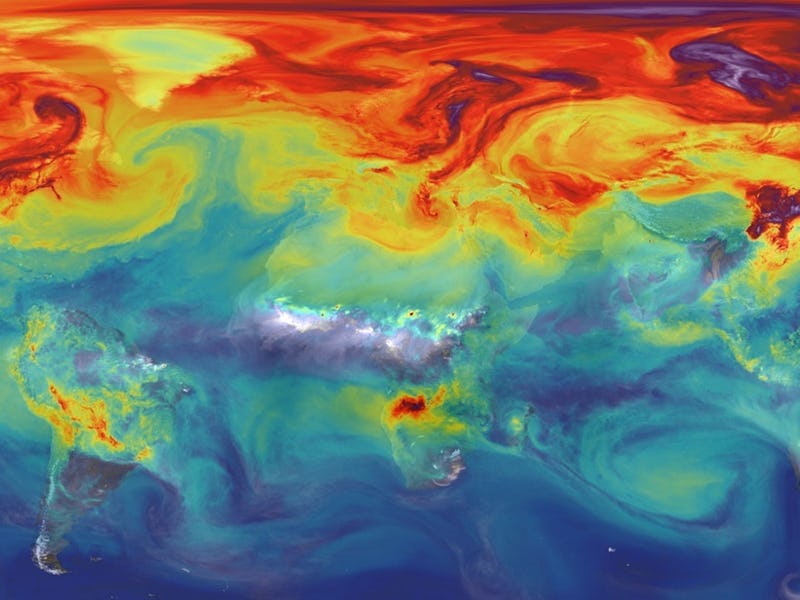NASA Will Use New Tech to Unearth the Other Half of Climate Change Data
By researching the ways carbon emissions get absorbed into the land and ocean.

NASA isn’t just the world’s preeminent space agency, it’s also a powerhouse for earth science research — especially when it comes to understanding climate change. The agency just held a news briefing to detail the work its Earth sciences division is doing in measuring and observing changes in carbon dioxide emissions — and the big takeaway is that the administration is making an intense new push to accrue data on the carbon that isn’t in the air.
Some 50 percent of carbon dioxide emitted by fossil fuels gets absorbed by the ocean and land plant life. It has always been thus, but the delta here is key: Carbon measurements of the air and atmosphere can only tell half the story.
“Carbon is an essential element for life on Earth,” says Michael Freilich, director of NASA’s Earth Science Division. It plays an essential role as a greenhouse gas in stabilizing the environment and keeping the Earth habitable. Unfortunately, as the amounts of carbon dioxide in the atmosphere has risen from 270 parts per million to over 400 parts per million. Levels continue to rise 2 parts per million every year. And with that, Earth’s average temperatures have gone up 1.83 degrees Fahrenheit. Freilich emphasized that it is now a key objective for NASA to understand the carbon cycle better, and the space agency is ramping up satellite technology for three major research projects.
The first is North Atlantic Aerosols and Marine Ecosystems Study, or NAAMES, which is primarily concerned with studying algal blooms and plankton life processes as it relates to carbon absorption from the air. In just the last few years, satellite technology has played a prominent role in helping to reveal how plankton populations grow and shrink, and the role to which algal blooms take up excess carbon dioxide as well as expel their own aerosols into the air (which incidentally can create some really sweet clouds).
Of course, while satellites have been very helpful for moving NAAMES forward, there is no substitute to running researchers out to sea on ships to study the ocean. “A lot of people think NASA is all about space exploration and satellites,” says Mike Behrenfeld, principal investigator for NAAMES’ field campaign. “But in fact, there’s a lot of ground work.”
An algal bloom in Lake Erie in 2011
The second big project involves studying land vegetation through satellite LIDAR — remote sensing technology that analyses reflected light from a distance. This has primarily been used to study how dense forests in rural parts of the world can help control carbon dioxide emissions. Current LIDAR satellites have gleaned some useful data, but “NASA is interested in scaling this technology up,” says George Hurtt, lead for NASA’s Carbon Monitoring System. Soon enough, NASA will introduce the world to Global Ecosystem Dynamics Investigation LIDAR. When it’s installed on the International Space Station in 2018, GEDI will be the world’s first high-resolution satellite instrument for studying ecosystems with dense vegetations.
Lastly, there’s Orbiting Carbon Observatory-2, NASA’s first satellite designed to directly measure carbon dioxide itself from space. OCO-2 now has a little over a year’s data under its belt, and has been able to track global year-round carbon dioxide patterns subject to seasonal events, like weather changes, summer fires, storms, and more.
Annmarie Eldering, deputy project scientist for the OCO-2 mission, emphasized the satellite has been able to gather 100 times more data about global carbon dioxide due to its sensitive equipment. “Carbon dioxide is such a powerful heat trapping gas,” she says. Gathering even small changes can reveal so much about the behavior of the carbon cycle in regions that can’t be readily accessed and studied.
As global warming continues to cause more and more problems around the world, all of this new data will be used to create models that predict what carbon dioxide trends will look like whether actions by the world’s governments is taken or not. “The carbon cycle is quite complex,” says Freilich. “There are processes that occurring on land, and there are different process occurring in the ocean.”
All of them impact carbon dioxide emissions in ways we still have little understanding of. By understanding the other half of the carbon equation, we can predict how much more (or less) time we still have to save ourselves from calamity.